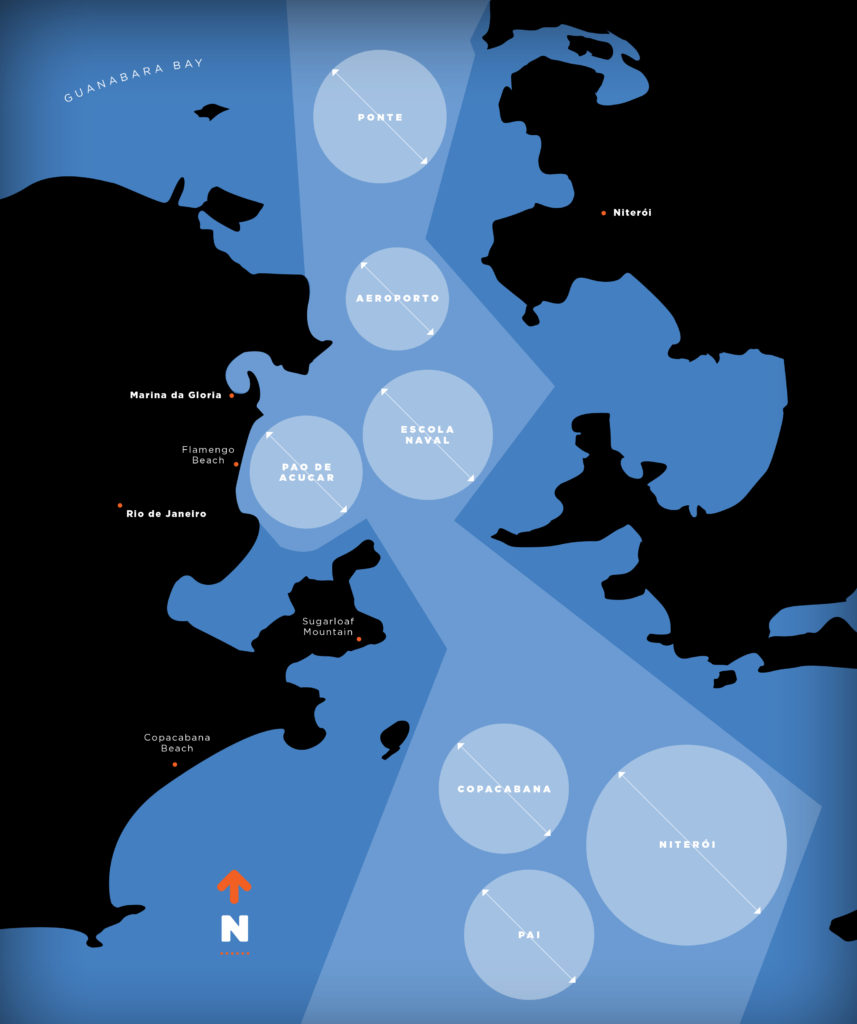
There are seven racecourses in Guanabara Bay. If the schedule isn’t adjusted for weather or pollution, every fleet will cycle through all racecourses, which Malcolm Page, chief marketing officer at World Sailing, says were intentionally spread throughout the bay and outside it to provide the most variance in conditions possible for competitors.
Ponte
Ponte is the most consistent course, windwise. “The bay opens up there to create more even current across the track as well,” says Page. The biggest challenge for organizers will be dealing with pollution. At the 2015 test event, the 470 classes were forced to sail elsewhere when Ponte was littered with floating debris. While cleanup efforts have been boosted dramatically since then, the Games will be the ultimate test of these improvements.
Pao de Acucar, Aeroporto and Escola Naval
Guanabara Bay is 160 square miles of water and less than a mile wide at its narrowest point, which is south of the three other interior racecourses. At peak tidal flow, the current accelerates through this point in the bay. “The current lines are unlike anywhere else I’ve ever sailed in that they move fast and they’re quite visible,” says 49erFX sailor Helena Scutt. “I’ve never sailed anywhere with such stark current contrasts.”
The Aeroporto course is situated almost evenly between the two sides of the bay, so current will be strong but consistent across the course.
The Pao and Escola Naval courses will present more eddies and current variance. “I’ve seen completely opposing currents on opposite sides of those courses at the same time,” says Page. “Being close to land, the depth of the water changes dramatically across the courses and changes the current.”
Pao de Acucar will be the medal racecourse. A ticketed spectator area is west of the course, on Flamengo Beach. “The last day of the 2015 test event, we had the classes finishing 50 meters from the beach,” says Page.
The intent is to set the course the same way at the Games. Locating the racecourse close to the beach moves it away from the wind shadow of Sugarloaf Mountain. “It’s not clear, but it’s not right in the lee,” says Page. “We’ll see wind going to either side, and the game will have to be played accordingly, but there’s plenty of water between the course and the mountain.”
Copacabana, Niteroi and Pai
After the 2014 test event, 470 sailor Mat Belcher reported that the waves on the Niterói course were the biggest he’d ever sailed in. “We’ve sailed off Sydney Heads together in 12-meter swell,” says Page of Belcher. “That certainly means it’s big off Rio.”
The larger race areas provide more flexibility, and their location has fewer geographical boundaries, so there will be more variety in the course configuration outside. Besides coastal flow, Page says, the current is no different from any other continental coast. “You’ll get up to a knot of current,” he says. “Compared to the breeze, it’s a minor factor.” Rio’s sea breeze generally fills at 1 p.m. In the Southern Hemisphere winter during the Games, sunset will be around 5 p.m., creating a narrow racing window. “Having so many courses gives us flexibility with pollution, but also, and more importantly, [there are more racecourses] because of the weather,” says Page. “The variables are stronger in Rio than in many other places on the globe. We have to be conscious of it.” — Lisa Gabrielson









